Imagine your change initiative was faster, smoother, less risky, and delivered better outcomes. We can do this by focusing on human value.
This is what design can bring.
The reason a design approach is essential is that change is a human challenge and failure is generally due to human factors. Think about any change you have been involved with and you will have experienced challenges in a least some of these factors:
- power structures: change buts up against vested interests and shadow power;
- culture and mindset: when change is seen as ‘not how we do things around here’;
- behaviours: when change requires that people do things differently;
- networks of relationships: when change requires new relationships and routines.

Design is not just another change tool – it is the process of change, the activity of change. Design does this with people, exploring the future, getting familiar with it and working together to address the resistant factors -with respect.
A design approach enables you to integrate a wide range of perspectives in your change process. This brings more diversity to the table, reducing the unknowns and roadblocks that can derail change.
Design’s inherent tangibility makes change more real for all involved. We give it shape. We enable organisations to quickly identify added value and describe a long term vision. This reduces the ambiguity about what is being undertaken, proves what is possible and defines what the desired future looks like.
Creativity also provides an invaluable ability to reframe a challenge when change is required but gets stuck. When the solution is not provided by best practice or industry standards, design can imagine an alternative path.
Finally design aligns people and organisations to the value that their organisation exists to create. We ensure that technologies are guided by customer needs. We help people see what their part in creating value is with clarity. We orchestrate change.

In practice four qualities work together to make change happen. To help illustrate how, here are four examples that focus specifically on each quality.
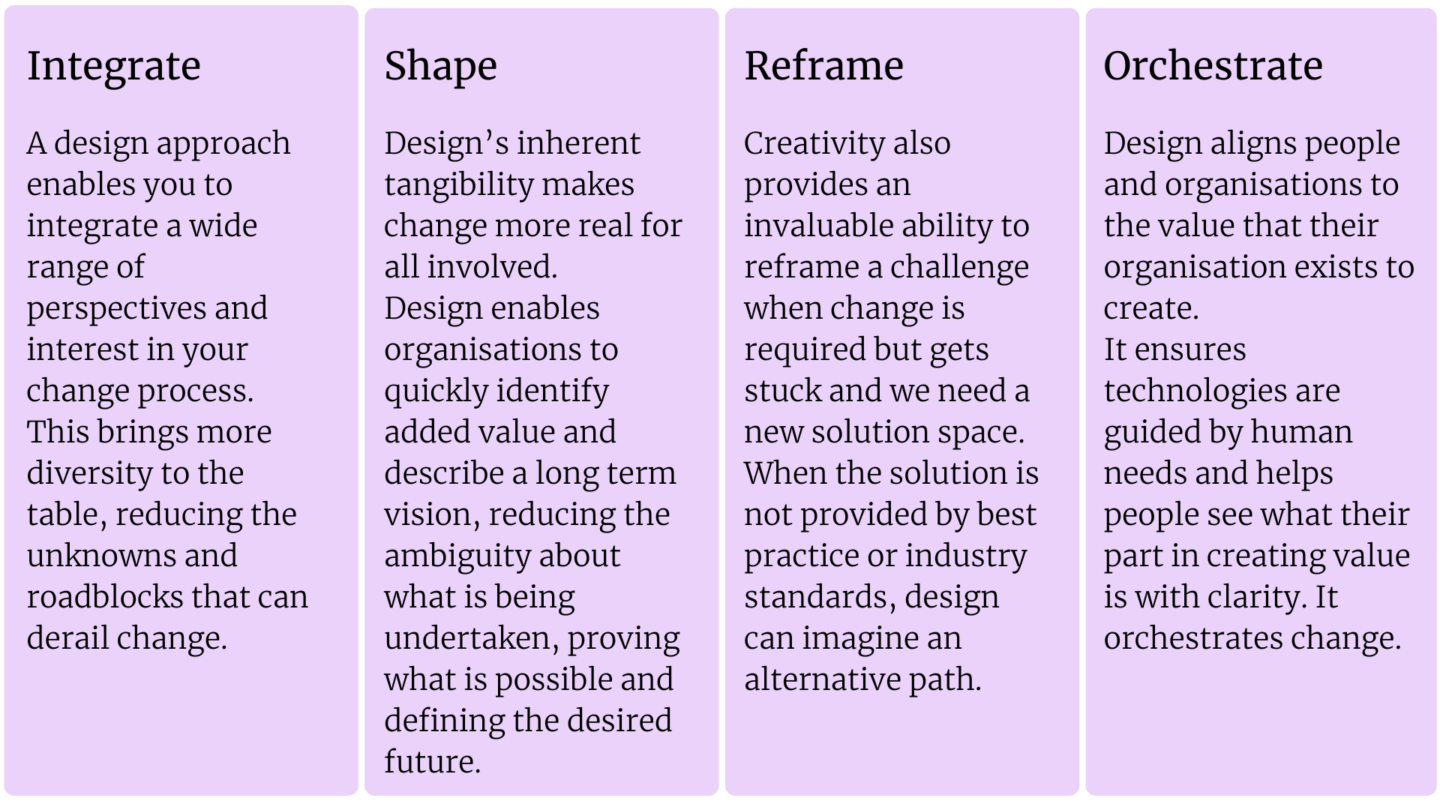
Change is a given for organisations – public and private. Drivers of change vary – from cost pressures to market ambitions – but the need to adapt remains or is accelerating. However, every change is a risk. A risk that the change fails or that it actually causes damage to the balance of an organisation.
Around 70 percent of change management programmes fail. There are a broad array of reasons for failure but employee acceptance of change is an accurate predictor of success. Deloitte
Only 21% of companies are reaping the transformative value of digital. However for those employing a strong customer focus that number rises up to 53%. HBR, Genpact
If design is the solution, what is the problem?
If we dig into these two statements, we can find the answer to our question.
Change management fails and technology transformations underachieve because employees and customers are missing from the picture. Organisational change is fundamentally a human process so missing on two huge human constituencies is a huge gap. Either employee acceptance or customer focus is lacking. Failure follows.
The core problem of management approaches is the Achilles heel of its strength. Single-minded focus on business goals and their delivery excludes wider perspectives. For example, frontline knowledge of how things work is neglected, leading to both lost know-how and demotivation. The issue becomes greater when important perspectives are excluded to the extent that the system breaks.
“These are the kinds of problems you can’t manage your way out of. You have to design your way out of them.”
“These are the kinds of problems you can’t manage your way out of. You have to design your way out of them.”
- Marty Neumeier, The Designful Company
In response to the management issue – we need something in our change approach that works more coherently with the context of change to ensure that perspectives are better integrated. We need the ability to reframe the direction we are taking once we understand how these perspectives come together in a specific situation.
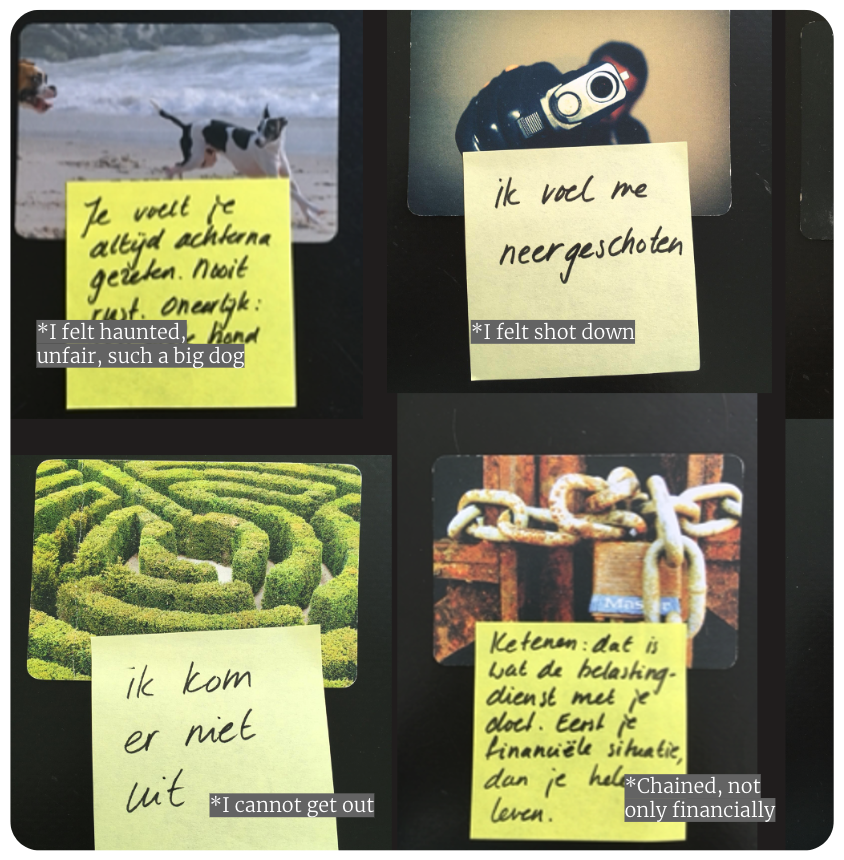
A Dutch government department. In the recovery process of a high profile welfare payments scandal citizens who were severely harmed by the government were offered financial compensation. Yet the recovery process was in itself often traumatic for this group of people. By integrating a deep understanding of the needs and perspectives of the parents, the legal perspective of our government, and the abilities of the executing organization(s) we were able to come to a shared reframe of the recovery process. The shared new perspective was that recovery is not solely a financial matter, but a recovery of a relationship. Any change that would happen after this was through balancing these integrated perspectives and working from this frame.
Technology on the other hand has a user problem. When developed in isolation of an understanding of the needs, context, abilities and motivations of its users it is working blind. Often the approach is to just keep going until you get it right but this leads to escalating increase in costs, delay and the levels of dissatisfaction with change programs that executives and leaders are experiencing.
To address the blindspot of technology, we need to have a much clearer picture of the shape of the new ‘thing’ informed by the needs, context, capabilities and motivations of all its users. We can then orchestrate how the system of people, teams and organisations adopts and uses the technology.
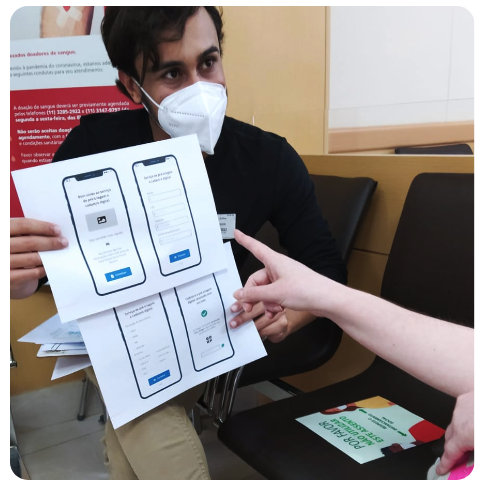
One of the largest health providers in Brazil wanted to explore a radical change to its core business model: What would care look like if the focus was on helping clients pursue healthy lifestyles instead of treating diseases and medical conditions? For this specific challenge, the shape quality of Design was activated right from the beginning. We visualised a person’s ecosystem with activities, motivations, people, establishments, and others that improve or treat their health during their lives. This map showed us where our client was active and where it could be present to foster a healthy-oriented way of living.Our team then moved on to imagining a new relationship journey and materialised the initiatives needed to take place using an analogy of the table of elements. Specifically in strategic and service change projects, the ability that Design has to give shape to concepts through artefacts is what allows employees from many different areas to understand and engage with invisible and intangible constructs, taking them further.
Design is first and foremost focussed on value. Specifically the value created for people. What value are we creating for the beneficiaries of our organisations activities? From this flows a focus on the people delivering the value – employees. This focus then informs the design of processes and systems that support people to achieve their goals – management and technology. Design provides the golden thread to the change program – the value it is creating for the beneficiaries of the organisation.
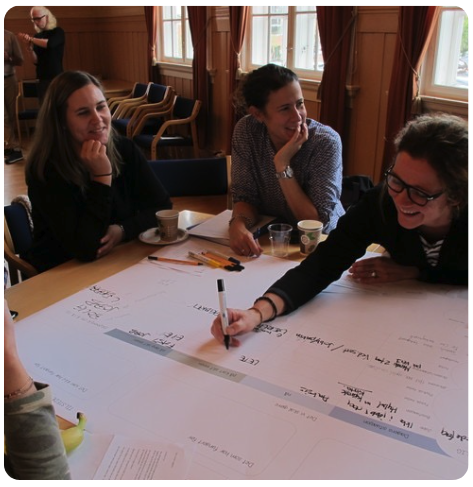
A central, and very old, UK institution was struggling to modernise. Its underpinning processes and systems were not meeting the needs or expectations of a modern workforce and inhibiting business. Technology upgrades had failed to deliver and change management efforts had floundered leaving a fractured workforce.
Employing design led change principles we took a highly inclusive approach and integrated the perspectives of the whole workforce and their users. We reframed their operating model around the services they provided. This service model provided a shape and a vision for the transformation to strive for. It also enabled us to orchestrate the services. We defined how they were run and how they would change as a whole portfolio, rather than disconnected parts, providing a way for the overall change to be governed. The organisation successfully moved from a three year change program into a new operating model of ongoing management and change.
We are not arguing for design to replace other approaches to change – more that it is a missing element. Think of management, technology and design as a three legged stool. Design provides balance where it is missing. Design provides a clear vision of what to do and how to do it. It does so by defining solutions that are valued by customers, deliver on business goals and provide a clear scope for technology. Of course design must work effectively with the other two legs.

Design is generally understood as the ability to shape things. Historically tangibles like chairs, cars etc. More recently our digital products and services are understood as designed. Design has made its way into unusual places such as banks, hospitals and government.
What we are adding here is that design brings value not only to the new thing that is being created but to the capability of an organisation to create that new thing. The capability to change in itself.
Bringing this together we need to have the capacity to change, to adopt change and to benefit from change. This clarity helps us to identify what is core to this change – It is the people, humans, involved in the change. The staff, the managers, the customers, the users. It is people in all their complexity – their behaviours, their mindsets, their power dynamics and their relationships that have to change for change to happen. We can blast through these factors creating damage or failing on the way, or we can bring them into the process, understand what we are changing and grow the human capability to change.
Design is the change as it happens
To conclude; what makes design so valuable to change is that it works at two levels.
Design delivers the future state. Through the inherent ability to describe and define the future – and to do so from the perspective of the customer or beneficiary of the change. To do this with the people who will be involved in delivering and managing it and to do this with a systemic lens. Design is able to connect the strategic vision to the specific details.
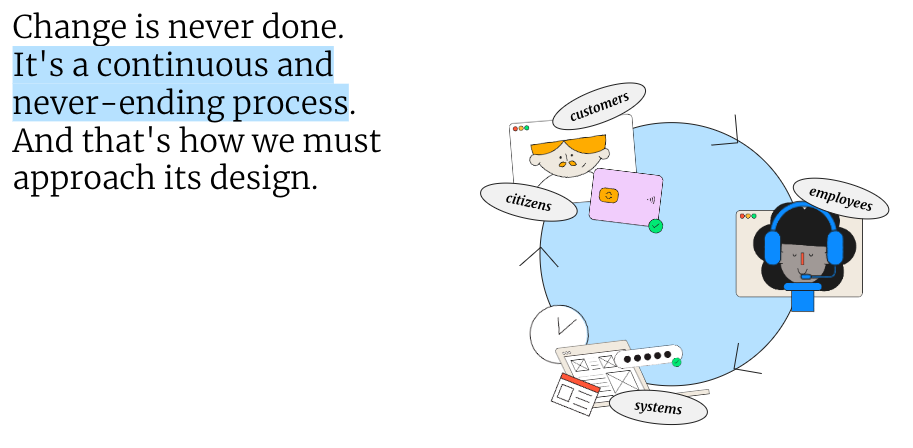
Design also delivers the capability to change. By integrating perspectives and orchestrating the change, design provides a change methodology that brings people – customers, users, staff and stakeholders – into the process of change. Design addresses these fundamental barriers.
Some of our projects:

I’m a believer that Service Design is vastly more than designing services. It is the systemic understand of your whole company through the lens of your customer. It is the catalyst for change and the north star that marries your customer, talent, operations and technology. For those in the know, SD is the happy path on which you will pivot from ESG to regenerative strategies – building a sustainable future for your corporation. I’m our chief ambassador to engage customers in SD.

